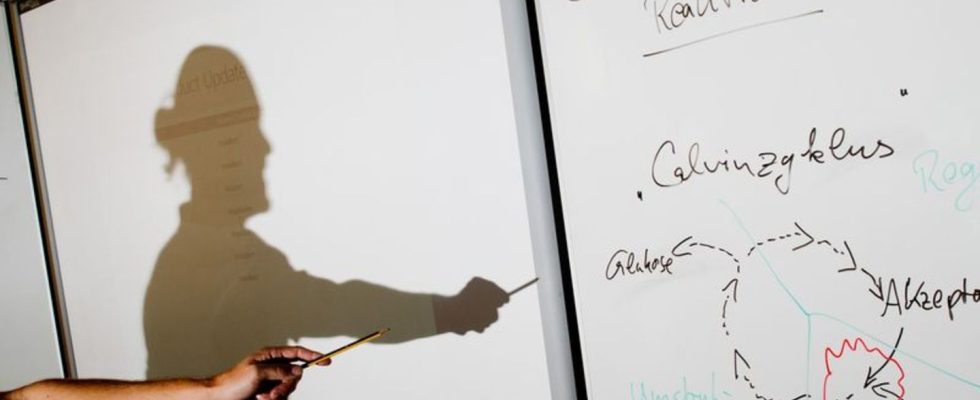Digital Pact School
Federal-state dispute over school digitalization escalates
A teacher casts a shadow on a smartboard in an advanced biology course. The federal states expect a subsidy of 6.5 billion euros for a continuation of the Digital Pact School 2.0. photo
© Julian Stratenschulte/dpa
What’s next with school digitalization? The federal and state governments are not making any progress in their negotiations on this. The dispute reaches a new height and there is a sum on the table.
In the dispute about the continuation of the funding program Digital pact for schools, the tone between the federal and state governments has become significantly more tense. From circles in the Federal Ministry of Education in Berlin it was said that it would be of little help if untruths were spread about the negotiations on the digital pact and false assumptions were made. “The Federal Ministry of Education never questioned the Digital Pact 2.0.” If it is to be a success, the Schleswig-Holstein Education Minister Karin Prien (CDU)’s attempts to raise its profile must “finally stop”.
Prien, who is also the coordinator of the Union states in the Conference of Ministers of Education and Cultural Affairs (KMK), had accused the federal government of not sticking to promises. The federal government canceled various negotiation dates on the so-called Digital Pact 2.0 at working level, which were part of an agreed schedule. Against this background, the states also had a discussion with Federal Education Minister Bettina Stark-Watzinger (FDP) as part of the KMK yesterday.
Cleansing conversation or not?
Saarland Education Minister Christine Streichert-Clivot (SPD) said after the conclusion of the KMK in Berlin that it had been a “cleansing and good conversation” and that we were now back on the right path, but that no time should be wasted. Everyone was waiting for a house number as to how big the Digital Pact 2.0 would be. You need this to ask all further questions.
After the conversation with Stark-Watzinger, Prien expressed the hope that an agreement on digital point 2.0 could be reached in May as planned, but renewed her very critical statements towards the Federal Ministry of Education: She expected that the agreements reached would be adhered to on schedule. She was very surprised that these had been “unilaterally terminated”. “That caused great irritation. Many of us spoke of a breach of trust.” She hopes that such irritations will not occur in the next few weeks and months.
With regard to the expected billion-dollar costs for the second digital pact, Prien added that they were aware of the federal government’s difficult budget situation, but it was by no means easier in the states.
It’s about follow-up financing worth billions
The Digital Pact for Schools is a funding program for the technical expansion of schools. It was launched in 2019 for five years with an initial five billion euros from the federal government for the development of schools’ own WiFi or for the purchase of interactive boards (smartboards). In the wake of Corona, the program was further increased to 6.5 billion to finance tablets, laptops and administrators.
The digital pact expires this year. In its coalition agreement, the traffic light announced that it would launch a follow-up program with the federal states, a “Digital Pact 2.0”, which will run until 2030. There have been tough negotiations about this for a long time now. And now that it has become clear how cash-strapped the federal government is now, it has become even tougher. In principle, schools are a matter for the states and not for the federal government.
Federal states want 6.5 billion again
The federal states are betting that just as much money will come to the table as with the first digital pact. This became clear after the conclusion of the Conference of Ministers of Education and Cultural Affairs. Prien spoke of 6.5 billion euros over five years. “That is the scale for us and we will now have to talk about who has to bear which quotas.” SPD representatives from the KMK joined this. For them, the first digital pact is the model and starting point for the negotiations, said Prien. Here the federal government provided 90 percent and the states 10 percent of the funding.

